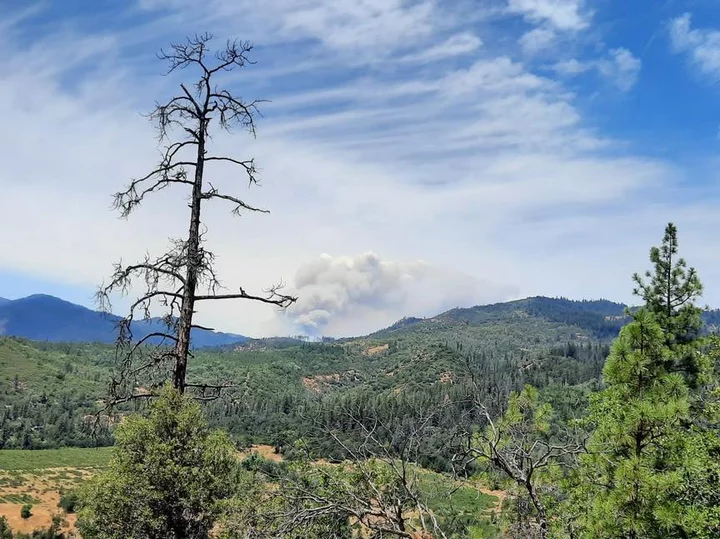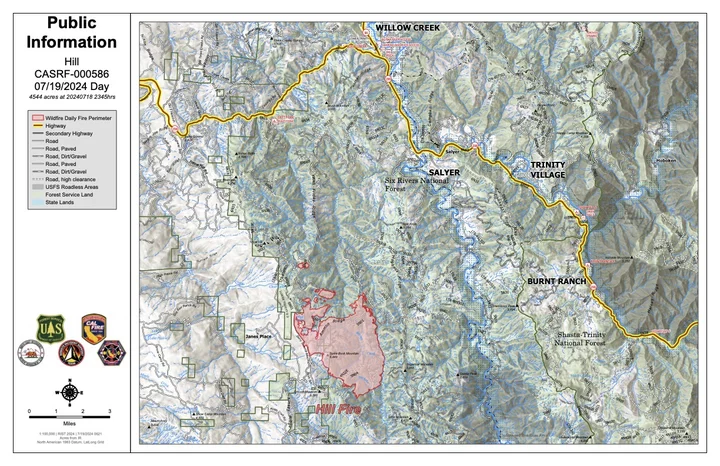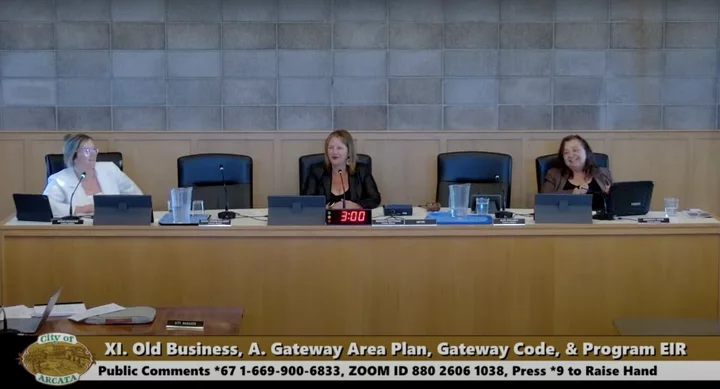Hill Fire Held at 4,544 Acres, 0 Percent Containment
LoCO Staff / Friday, July 19, 2024 @ 10:22 a.m. / Fire
Hill Fire as seen from Hyampom. Image via Six Rivers National Forest.
###
As of Friday morning, the Hill Fire burning south of Willow Creek has grown to approximately 4,544 acres with 0% containment.
An evacuation order remains in place for residents in Zone HUM-E077-A. The evacuation order for HUM-E077-C has been downgraded to an evacuation warning. Still, residents should “be ready to leave at a moment’s notice if conditions deteriorate,” according to the Humboldt County Sheriff’s Office.
The following additional information comes from Six Rivers National Forest:
Yesterday, spot fires along Friday Ridge were successfully contained. Firing operations were completed along Route 1, reinforcing that road as a potential containment line. Crews constructed direct and indirect dozer line along the south and southwest corner of the fire and continued to scout along the west side of the fire for opportunities to go direct.
The latest Hill Fire perimeter map. Click to enlarge.
Today firefighters will continue with firing operations along Route 1 to reinforce that potential containment line. Crews will mop-up the spot fires to the north to ensure they stay within the footprint of their fire perimeters. Crews will also continue scouting to the north and east of the fire for opportunities to go direct or possibly indirect depending on potential risk to firefighter safety. As a precaution, a structure protection group will be assessing structure protection needs within the communities of Friday Ridge, Willow Creek and South Fork Road. Air resources continue to perform water and retardant drops along the perimeter of the fire. Despite commercial airline disruptions, incident air operations will not be impacted.
Fire weather includes low humidity recovery along the ridgetops, continued dry conditions, with temperatures in the 80’s along the ridgetops. Winds will be north and northwesterly with gusts up to 10- 15 mph during the day.
Fire behavior is expected to be relatively moderate, similar to yesterday with flanking and backing activity to the north. The north side of the fire is burning within the footprint of Ammons fire where the fuels are sparse which results in minimal fire behavior in that area. There is potential for growth to the south of the fire due to the north/northwesterly winds.
Evacuation Information:
Evacuation order and warnings remain in effect. For current updates on evacuations, visit https://www.facebook.com/HumboldtSheriff and https://humboldtgov.org/2383/Current-Emergencies. Conditions are subject to change at any time, visit https://protect.genasys.com/search for a full zone description.
Sign up for Humboldt Alert emergency notifications at https://humboldtgov.org/2014/Emergency-Notifications.
Closures:
Forest Closure Order currently in effect for the area impacted by the Hill Fire. It is temporarily prohibited to be on any national forest system land, trail, or road within the closure area. To view the closure order and map of closure area visit the following link www.fs.usda.gov/Internet/FSE_DOCUMENTS/fseprd1191963.pdf
Road closures are currently in place on Friday Ridge Rd. at Forest Service Route 6N06, Friday Ridge Rd. at Forest Route 5N01 and Friday Fridge Rd. at Forest Route 5N04. For updated road closure information, visit protect.genasys.com or humboldtsheriff.org/emergency.
Fire Restrictions:
Forest fire restrictions currently in effect across the Six Rivers National Forest. Campfires and stove fires are restricted to those developed areas listed in the forest order located at https://www.fs.usda.gov/Internet/FSE_DOCUMENTS/fseprd1188610.pdf.
Smoking, welding, and operating an internal combustion engine also have restrictions in place.
BOOKED
Today: 4 felonies, 8 misdemeanors, 0 infractions
JUDGED
Humboldt County Superior Court Calendar: Today
CHP REPORTS
No current incidents
ELSEWHERE
County of Humboldt Meetings: Behavioral Health Board Executive Committee Meeting - Nov. 5, 2025
Governor’s Office: One year after Los Angeles firestorms, California continues statewide recovery and behavioral health support
Fishing the North Coast : Dry Stretch Sets the Stage for Prime Steelhead Conditions
Governor’s Office: Governor Newsom delivers final State of the State Address, honoring California’s past and reaffirming a brighter future for all
‘Pass the Torch’: Huffman Joins Calls for President Biden to Step Aside
LoCO Staff / Friday, July 19, 2024 @ 8:58 a.m. / Politics
Huffman and Biden. | Official portraits via Wikipedia.
###
Rep. Jared Huffman this morning joined the growing chorus of Democrats calling on President Joe Biden to step aside as the party’s 2024 nominee.
Huffman and three of his colleagues in the U.S. House of Representatives publicly issued a joint statement urging Biden to “pass the torch” to a younger generation of party leaders.
Here’s the introductory message Huffman posted to social media, followed by the statement:
Thomas Paine famously said, “the times have found us.” I believe winning this election is a moral, democratic, and existential imperative. With that in mind, and with a firm belief that we can turn this around and win, here is the statement I am releasing this morning with three of my congressional colleagues:
###
Joint Message to President Biden from Representatives Jared Huffman, Marc Veasey, Chuy Garcia, and Mark Pocan
Washington, D.C. - Today, U.S. Representatives Jared Huffman (CA-02), Marc Veasey (TX- 33), Chuy Garcia (IL-04), and Mark Pocan (WI-02) released a joint message to President Joe Biden:
“Mr. President, with great admiration for you personally, sincere respect for your decades of public service and patriotic leadership, and deep appreciation for everything we have accomplished together during your presidency, it is now time for you to pass the torch to a new generation of Democratic leaders. We must defeat Donald Trump to save our democracy, protect our alliances and the rules-based international order, and continue building on the strong foundation you have established over the past four years.
“At this point, however, we must face the reality that widespread public concerns about your age and fitness are jeopardizing what should be a winning campaign. These perceptions may not be fair, but they have hardened in the aftermath of last month’s debate and are now unlikely to change. We believe the most responsible and patriotic thing you can do in this moment is to step aside as our nominee while continuing to lead our party from the White House. Democrats have a deep and talented bench of younger leaders, led by Vice President Kamala Harris, who you have lifted up, empowered, and prepared for this moment. Passing the torch would fundamentally change the trajectory of the campaign. It would reinvigorate the race and infuse Democrats with enthusiasm and momentum heading into our convention next month. Mr. President, you have always put our country and our values first. We call on you to do it once again, so that we can come together and save the country we love.”
OBITUARY: Carl Fullbright, 1942-2024
LoCO Staff / Friday, July 19, 2024 @ 6:45 a.m. / Obits
On June 15, 2024, after a 23-year-long disagreement with prostate cancer, Carl Duane Fullbright passed away in his Arcata home in the comfort of family and friends.
Born October 17, 1942, to Omar and JV Fullbright in Los Angeles, CA, Carl grew up in Pico Rivera with his parents and younger brother, Harrol, graduating from Sierra High School in 1960. Carl was an athlete who played football, ran track, wrestled, and surfed countless Southern California beaches. After one too many moving violations, Carl ended up in front of a judge, who “suggested” that he enlist in the military. Convinced, he joined the Air Force, serving at multiple posts, including Cambria, California, and Kotzebue, Alaska. Carl considered these days as pivotal to his life because it was here that he “opened up a book and found that I had a brain.”
Upon returning home, this epiphany led him to attend UC Irvine, where he graduated with honors, and ultimately to a rewarding career in medicine. Graduating from the USC Keck School of Medicine in 1970, Carl became one of the first board certified emergency room physicians in the United States at Long Beach Community Hospital. It was there and at West Anaheim Medical Center that he met a group of physicians who became his lifelong friends. During this time he also met the love of his life, Anita. In 1980, Carl and Anita moved to the Central Coast, where he continued his medical career at General Hospital in San Luis Obispo, served as the San Luis Obispo County Director of Emergency Services, and began work as a physician at the Cal Poly San Luis Obispo Student Health Center. Carl also nurtured and cherished time with Anita and their four daughters, taking them on numerous adventures canoeing in Morro Bay, hiking sand dunes, and going to Avila Hot Springs.
Ten years later, drawn to the beauty of the redwoods and the North Coast, Carl took a job at the Student Health Center at Humboldt State University, serving as director during part of his tenure. Valuing the challenge and impact it provided, he also continued his role as an ER physician at Redwood Memorial and Mad River Hospitals, ultimately retiring in 2002. Though an expert diagnostician with a vast understanding of medicine, Carl’s joy and focus centered on developing connections with patients and providing personalized healthcare. He flourished working at
the university health centers because he loved interacting with the students. This ability to make and sustain genuine relationships meant that he always had a friend, and time for that friend, wherever he went. From an early age, his grandchildren noticed that wherever they went – whether at the Co-Op, Starbucks, or the beach – he would always end up deep in conversation with someone, even strangers. “Boppy knows everybody!” they would joke.
Carl lived a rich life full of adventure, play, and a deep appreciation for music, art, and food. A lifelong surfer, he was a member of the North Swell Surfing Association, where he made countless friends and memories. Throughout his life, Carl would venture to his favorite spots at the Jetty or his beloved Camel Rock to check the swell, which way the wind was blowing, and who was in the lineup. Even when standing on shore, his spirit was out among the waves. After retiring, Carl and Anita fulfilled a lifelong dream of spending summers living on their sailboat in Hawaii. They returned to Humboldt full of the Aloha Spirit that characterized their life together: loving, generous, and fun. Life was never boring with Carl, and many of his grandchildren’s most cherished memories involve spending time with him, combing the shore for driftwood, crab shells, or walking sticks, making music together, or following his neon orange baseball cap as he maneuvered through the Farmer’s Market.
Carl was a man who put his loved ones at the center of everything he did. He leaves behind an extended network of family and friends bound by their love for him and strengthened by the depth of their memories. Preceded in death by his father, JV Fullbright, he is survived by his wife Anita; mother, Omar; brother Harrol and wife Pat; daughters Kirsten and husband Carl, Monika, Katie and husband Brian, and Jennifer; his nine grandchildren, Hanna, Kyle, Brienna, Peter, Leah, Nathan, Olivia, John, and Ben, along with three great-grandchildren, Beck, Junie, and Addie; as well as countless relatives and friends whose lives he touched.
The family gives special thanks to Carl’s oncologist from the start, Celestia Higano, MD, and dear friends Bill Hoopes, Jim Sanders, and Kurt Wendelyn, MD and his wife, Chris.
Carl Duane Fullbright was loved by all who knew him. His kind heart, generosity and sense of humor made everyone love being around him, for he had the rare gift of making anyone he was with feel special and cared for, and he did so with the utmost sincerity.
###
The obituary above was submitted on behalf of Carl’s loved ones. The Lost Coast Outpost runs obituaries of Humboldt County residents at no charge. See guidelines here.
OBITUARY: Silvia Leonardo, 1939-2024
LoCO Staff / Friday, July 19, 2024 @ 6:45 a.m. / Obits
With great sadness our beloved mother, Silvia Maria Leonardo passed away peacefully on July 8, 2024, at the age of 84 with both her children by her side.
Born December 21st, 1939, in Fortuna to John and Lena Saottini. Mom and her older brother Eugene were raised on their parents’ dairy and vegetable farm in the Coffee Creek area of the Ferndale Valley. Spending her entire life in Ferndale, she attended Coffee Creek Elementary School then graduating from Ferndale High School in 1957.
Marrying Frank Leonardo in the spring of 1962. Settling in Grizzly Bluff. Together side by side they worked the dairy. Raising their two children Lydia and Frank. Mother’s love for dairying led to her large cow collection, of which no two were alike. An avid card player, she enjoyed many hours spent with neighbors, friends and family playing her favorite card game ‘Pedro’. She liked to win!
Mom and Dad enjoyed traveling with family and friends. Most memorable were trips to Reno, Willows, Tracy and visiting Italy and Portugal (Azores) They were both very proud of their heritage.
Besides family, volunteering and interacting with community brought her so much joy. A proud and generous supporter of many organizations. A lifelong member of Assumption Catholic Church, the Ladies Guild, helping with the church bazaar and fundraisers.
The District 1 Dairy Princess contest was among Mother’s most rewarding and happiest days. So very proud of each and every contestant. Genuinely encouraging and comforting was her heartfelt nature. Her commitment to the contest and industry spanned over 40 years.
Not only serving on multiple Portuguese Celebration Committees over the years, she was also a member of the Supreme Council of the S.E.S. / PFSA organizations. Serving as Secretary of the Ferndale Council No. 98. Both Mom and Dad traveled throughout the state making forever friendships and memories.
Always eager to volunteer, Mother looked forward to sitting with friends and enjoyed greeting visitors of the Ferndale Museum.
Other organizations that she was a supporting member of were the VFW Ladies Auxiliary, Ferndale Lions Club, Portuguese Hall Association, and the Lady of Fatima.
Survived by her two children Lydia Leonardo and Frank Leonardo. Stepdaughter Merrilee Mosher and Step Granddaughters Shanna Borgensen and Jenna Leonardo.
Proceeded in death by her parents John and Lena Saottini, husband Frank H. Leonardo, brother Eugene Saottini, Stepson Mark F. Leonardo, Brother and Sister in laws Charles and Mary Manzi, Allen (Timer) and Evelyn Paine, and Ione Franz.
A rosary-viewing will be held at the Assumption Catholic Church in Ferndale on Sunday, July 28th from 6 pm – 7 pm. Reciting of the rosary beginning at 7:00 pm. Mass of Resurrection at the Assumption Catholic Church on July 29th at 11 am.
Concluding services for family burial will be at St. Mary’s Cemetery in Ferndale with reception to follow at Portuguese Hall.
Memorial contributions in Silvia’s honor may be made to Assumption Catholic Church – Maintenance Fund, Ferndale Museum or to any charity of your choice.
###
The obituary above was submitted on behalf of Silvia’s loved ones. The Lost Coast Outpost runs obituaries of Humboldt County residents at no charge. See guidelines here.
OBITUARY: Sonja Heaton, 1934-2024
LoCO Staff / Friday, July 19, 2024 @ 6:45 a.m. / Obits
Sonja Jensine Heaton passed peacefully from this life to “New Life In Christ” – June 24, 2024 while in her home in Eureka at age 90 – in the loving care of her family – who Honored her with the title befitting her beauty and her grace: “Queen of the Norwegians”… A Red Headed Twin from Ana-Sira Norway who immigrated to the USA at age 19 and taught us ALL the value of hard work, laughing when crying would be easier, and never giving up - no matter the obstacles - and there were many! The BEST Norwegian pancake maker, with a beautiful voice, a great dancer too and a heart for the downtrodden whose home never knew a stranger - always feeling welcome!
In her younger days, Sonja was fast on her feet, quick with her hands as well as her wit – finding humor in the ordinary and taking pride in every task - from Waitressing to Elder Care to Retail to Supervisor of West Coast Foods and last stop as Expert Saw Filer and Welder for Schmidt Bower Lumber (the Only Female in an All Male industry – unheard of in that day – yet successfully so) and All in efforts to provide for her family as a Single Mother of Five. With a great support system of family and friends, Mamma Sonja, as she was also fondly called, would strive to always OVERCOME and be that listening ear for her family and Others … to do the same!
A GREAT cook, who loved Bette Davis movies, the Opera of Mario Lanza and Gospel Inspiration of Mahalia Jackson (and, YES, her talented musical family as well!), MOM was also very competitive – in cheering on Team Norway for the Winter Olympics to her favorite NFL Vikings and Raiders - to picking shrimp – faster than the eye could see - to Harley Motorcycle Riding at Age 80 – and this just for starters! Mother was also a Life Long Member of the Sons of Norway (Lodge No. 13). Her love of Norway never left her, but her home in Humboldt County for 52 years - would be her mainstay AND final landing!
HER LIFE and LEGACY are her CHILDREN
JESUS is her SAVIOR
And WE as a FAMILY
Are ETERNALLY Grateful! (John 3:16)
THANK you MOM … for giving us the GIFT of LIFE
And then “GIVING us to JESUS” the ONE you KNEW would never Leave, Fail or Forsake us!
God PROVED that HE was and is FAITHFUL … And on that WE ALL agree!!
(Jeremiah 29:11)
With Honor, Gratitude and In Loving Memory,
Your Children,
Jensine Linda Bard, Daniel Lee Hawk, Cynthia Marie Christiansen, Austin Allan Backus and Lisa Renee Backus
SONJA is PRECEDED IN DEATH by her Parents: Einar and Jenny Daastol; Brother: Erling Daastol, Twin Sister: Judith Egeland and her Daughters: Laila Ottersen and Aina Egeland; Brother-In-Law: Sivert Log and Nephew, Tollak Log – All of Blessed Memory. SONJA is SURVIVED by her Five (5) Children and their Spouses: Jensine (and Daniel) Bard; Daniel (and Renee-Rosenberg) Hawk; Cynthia (and Gary) Christiansen; Austin (and Belinda) Backus; Lisa Backus; Four (4) Grandchildren: Gabriel (and Sam Hinton) Hawk; Nathan Hawk; Zachary (and Roxie) Christiansen; Benjamin (and Sonja) Christiansen; Four (4) Great Grandchildren: Cameron (and Sarah) Christiansen; Cody Christiansen; Benjamin Christiansen (Son of Benjamin and Sonja) and Sonja Hawk (Daughter of Gabriel Hawk and Sam Hinton). Beloved Sister: Olga Log and Nephew, Alvin Log; Beloved Sister-In-Law: Colleen Daastol – Her Children and their Spouses: Philip (and Linda) Daastol; Karen (and Steve) Nichols; Jana (and Dennis) Brown and numerous Nieces and Nephews both in the U.S. and in Norway (Diana Ottersen and Family; Cathrin Ottersen and Family; Madelen Ottersen and Family; Einar (and Inger Johanne) Egeland and Family; Lena Egeland Hogstad and Family; Jannicke Egeland and Family) and gratefully so!
###
The obituary above was submitted on behalf of Sonja’s loved ones. The Lost Coast Outpost runs obituaries of Humboldt County residents at no charge. See guidelines here.
OBITUARY: Douglas Jager, 1939-2024
LoCO Staff / Friday, July 19, 2024 @ 6:45 a.m. / Obits
It is with heavy hearts that we announce the passing of Douglas John Jager, PhD, Emeritus Professor of Forestry and Watershed Management, Humboldt State University. Doug died on June 7, 2024, at his north Trinidad home with his loving family by his side.
Born in Oakland, California, on New Year’s Eve 1939, Doug boasted that he never had to go to school or to work on his birthday and that people across the nation celebrated his special day.
The middle child of Cornelius and Anne Jager, Doug grew up in east Oakland living next door to his Dutch immigrant Vermeer grandparents at a time when it was safe to ride his bicycle around the area. One of his favorite childhood adventures was to ride horses with his friend all over the Oakland Hills. An industrious lad, Doug had a paper route, helped an electrician, worked for a medical supply company, pumped gas in a service station, and set tile with his dad.
After graduating from Fremont High School in Oakland, Doug attended junior college and then transferred to Humboldt State College where he majored in forestry. On campus, in the dining room of the Nelson Hall dorm, he met Nancy Foster, an elementary education major from Ukiah, California. They were married on August 13, 1961, at the Ukiah Methodist Church and had sixty-two wonderful years together.
Doug loved teaching and the interactions with his students. He began as a teaching assistant in forest engineering during his junior year at Humboldt State. After earning a Bachelor of Science in Forestry, he continued to teach in both forestry and watershed management while earning his Master of Science in Forestry. He then went on to teach forestry at the University of Nevada while completing his PhD in Wildland Hydrology. Doug returned to Humboldt State in 1973 as a professor of Forestry and Watershed Management and retired as Emeritus faculty in 2000. He was known as a hard teacher, earning the nickname of “clear cut.” He was not sure if it was because of his short haircut or his forestry philosophy.
Doug and Nancy, a retired elementary school teacher, have two wonderful children. Christopher, a retired commercial fisherman and fishing boat captain, was born in 1967 in Arcata. Doug passed down his love of fishing and firewood cutting to Chris. Sally was born in 1969 in Reno, Nevada, and is a retired elementary school teacher. Sally inherited Doug’s passion for horses at an early age. Chris and Sally both took excellent care of their dad during his senior years and final days.
Throughout the years Doug had many hobbies. He enjoyed riding his bicycle and motorcycle, driving his sports car and tractor, sailing his catamaran at Big Lagoon with his family, canoeing the local rivers and lagoons, and boating at Lake Tahoe and Big Lagoon. Doug also loved surf, bass, trout, and ocean fishing, horseback riding at the local beaches, Trinidad State Park, and Redwood National Park, growing and selling Redwood tree saplings to the locals and tourists of Humboldt County, and sitting around the backyard pool reading, visiting, napping, and enjoying the beautiful outdoor surroundings of his home of over fifty years. During their later years, Doug and Nancy traveled the western states in their motorhome and enjoyed cruises to Mexico, Alaska, and Hawaii with family.
In 1985 Doug started 4-H TRAIL, a Humboldt County 4-H program, to provide therapeutic horseback rides to individuals with special needs. With the help of countless volunteers, the program took place in the backyard of his north Trinidad property, widely known as Camelot Stables. Doug enjoyed sharing his love for horses with others. Doug was a fearless horseman and had a lot of great trail rides on his favorite bold horse named Bert. Participants and volunteers of 4-H TRAIL will remember Doug’s entertaining stories about the “Molagoona’s” unique nesting habits in the woodshed and about their sneaky shenanigans in the surrounding Redwood trees in the Trinidad area. The 4-H TRAIL program is still ongoing under the direction of Doug’s daughter Sally. Doug had received the Horseman of the Year award from the Northern California Horseman’s Association for his dedication to 4-H TRAIL and the horse community. In 1980 Doug opened a retail horse tack and equipment store called Camelot Tack. He was well known for catering his inventory to the English equestrian and providing excellent customer service. Somehow, in a small storefront at the stable, Doug managed to stock everything a horse person may ever need. Doug was a forty-year Humboldt County 4-H Project Leader. In 2008 he received the League of Women Voter’s award for contributions to the community.
Doug was a registered professional forester and had worked on Redwood tree and watershed research and projects in Southern Humboldt and Northern Mendocino counties including the Mattole and Bull Creek areas. A conservationist, he belonged to numerous groups including The Society of American Foresters, the Nature Conservancy, the Sierra Club, and the Audubon Society. He was a founding member of CHERT, a Humboldt County team of scientists reviewing and making recommendations on gravel extraction on the Mad, Van Duzen, Smith, and Eel rivers. Doug previously served on the local Trinidad Volunteer Fire Department and was a past president of Rural Trinidad.
Doug was preceded in death by his parents Cornelius and Anne Jager, stepfather Victor Fogh, older brother Clifford Jager, daughter-in-law Colleen Jager, in-laws Alfred and Vivian Foster, brother-in-law Martin Davis, and sister-in-law Linda Foster.
Doug is greatly missed by Nancy, his devoted and loving wife of sixty-two years, son Christopher Jager (Greta Daniels), daughter Sally Friedley (Clifford), grandsons Travis Pederson (Candace), Aaron Friedley (Josephine Fodge), and Chris Friedley (Jasmine Collins), his younger brother William Jager (Sharon), sister-in-law Odette Jager (Clifford), Nancy’s siblings Susan Davis, Tom Foster, and Bonnie Snearly (Larry) as well as many adoring nieces, nephews, and cousins.
The family would like to express sincere thanks to the local medical community for many years of excellent care. Special appreciation goes out to Sophia and her staff at Providence St. Joseph Home Health, as well as Dr. Larry Senffner, Dr. Steven Aussenberg, Dr. John Fjerstad, and Dr. Thomas Taylor and their staffs.
No services are planned. A private family gathering will be held later. In lieu of flowers, donations to honor Doug may be made to 4-H TRAIL, 349 Stagecoach Road, Trinidad, CA 95570, or to a charity of your choice. Feel free to skip a rock across a stream or lake, listen to Andre Rieu orchestra music, play a game of solitaire, chop some wood and build a fire in the wood stove, eat a bowl of ice cream, or take a horseback ride in Doug’s memory.
###
The obituary above was submitted on behalf of Douglas’s loved ones. The Lost Coast Outpost runs obituaries of Humboldt County residents at no charge. See guidelines here.
HELLO, GATEWAY: Arcata City Council Passes Gateway Area Plan and Welcomes New City Manager Merritt Perry
Jacquelyn Opalach / Thursday, July 18, 2024 @ 5:06 p.m. / Local Government
Arcata City Council Member Sarah Schaefer, Mayor Mayor Meredith Matthews and Councilmember Kimberley White discuss approving the Gateway Area Plan. Screenshot.
The Arcata City Council approved a final draft of the Gateway Area Plan last night, nearly four two and a half years after the City published a first draft of the blueprint to infill 139 acres of southwest Arcata with high-density housing.
The Council tied up loose ends related to the linear park along L Street and discussed how recent alarm over fire safety in the high-density neighborhood can and will be addressed post-plan approval. (Vice Mayor Alex Stillman and Councilmember Stacy Atkins-Salazar recused themselves from the Gateway Area-related discussion due to conflicts of interest.)
What will happen to L Street has been one of the plan’s hotter topics throughout its development. The street was once slated to become a one-way (in addition to K Street) but the City Council ditched that idea after it stirred opposition in the community.
In its final draft, the plan directs the City to get started on a linear park and a woonerf along L Street – stretching from Samoa Blvd. to 11th Street – within two years.
The plan defines a woonerf as “low-flow, slow-speed, local traffic only street that is designed to safely accommodate bikes, pedestrians, and play, as well as limited use for vehicles,” while a linear park is vehicle-free. Councilmember Sarah Schaefer said it’s likely the woonerf will run from 7th Street to 11th Street (where there is already an existing road), and the linear park will go from 7th Street to Samoa Blvd. Though some commenters asked for specific wording in the plan to guarantee restrictions for the woonerf and linear park, the Council opted to keep the language more open-ended.
Fears over fire safety in the to-be-densified neighborhood have become the other sticking point for some Arcatans. Arcata Fire District Board President Eric Loudenslager and Fire Chief Chris Emmons have said that the fire department currently lacks the staff and resources to address emergencies in tall buildings. An investigation released last month by the Humboldt County Civil Grand Jury found that the department is indeed financially strained.
However, a standards of coverage analysis co-funded by the City of Arcata, the Arcata Fire District and Cal Poly Humboldt will assess future needs of the department, and may identify potential funding sources. That’s expected to wrap up in October.
Public commenters appeared to again call out potential fire risks. Their concern is this: the plan will be passed, buildings will be built, people will move in, and the fire district will fall short in an emergency.
But that series of events excludes some processes and doesn’t reflect how long each of those steps will take, Arcata city staff and council members pointed out. For instance, the standards of coverage analysis will be far past complete by the time builders break ground, and avenues to funding and resources may be well on their way.
When the standards of coverage analysis is done, the Council may amend the plan or code as needed, City Manager Karen Diemer said; it’s a living document.
Meanwhile, the City is actually waiting on the Arcata Fire District board to develop language for fire code. Although there is, technically, fire code currently included in the Gateway Code, “it cannot be effective until the fire department takes action, sends that ordinance to us, asks us to adopt it, [and then] we can either adopt it as is, or amend it,” Community Development Director David Loya said. “Then it will be effective in our code.”
“I know this is an issue that has captured our imaginations,” Loya said. “The reality is that modern building code builds buildings that really don’t catch on fire like that. They’re sprinklered, you’re not going to have a Chicago-style blaze where these buildings are burning down.”
Mayor Meredith Matthews pointed out that local fire departments provide mutual aid, and that seven story buildings are already underway within city limits.
“I think that this fear that: ‘oh my god, it’s gonna happen, and people are gonna be unsafe, and they’re gonna die in a multistory building fire’ is really really outlandish and unrealistic and probably not going to happen,” Councilmember Schaefer said.
“The fire marshall signs off occupancy of buildings, and if we were really in a dire situation where the fire department said: ‘there is no way we can help defend this building,’ then they’re not gonna certify its occupancy and let people live in it.”
Although Councilmember Kimberley White was more concerned than her peers about the fire issue, the three ultimately passed a motion to approve the Gateway Area Plan and Environmental Impact Report, and to introduce an ordinance to adopt the Gateway Code (which will likely be approved at their Aug. 7 meeting).
After Vice Mayor Stillman and Councilmember Atkins-Salazar rejoined the group, the Council quickly and unanimously passed the General Plan 2045. The meeting ended with the Council’s approval to hire Merritt Perry as Arcata’s new city manager. He will replace Diemer next month.
Perry told the Council that he’s always loved opportunities to work in Arcata, from his years as an environmental resources engineering student at Humboldt State University to his time as a consultant in the civil engineering field.
“It was something that always really excited me, to be able to work where I went to school, and I received my education, where I raised my kids,” Perry said. “So I’m really excited at the opportunity to get to know the Council better and to hear the Council’s ideas, and to get to know the community.”








